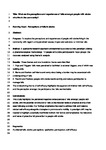What are the perceptions and experiences of falls amongst people with stroke who live in the community?
| dc.contributor.author | Munford, D | |
| dc.contributor.author | Gunn, Hilary | |
| dc.date.accessioned | 2018-12-07T11:44:35Z | |
| dc.date.issued | 2020-02-27 | |
| dc.identifier.issn | 0963-8288 | |
| dc.identifier.issn | 1464-5165 | |
| dc.identifier.uri | http://hdl.handle.net/10026.1/12999 | |
| dc.description.abstract |
Purpose: To explore the perceptions and experiences of people with stroke living in the community with regard to the perceived causes, impact and solutions to minimise falls.Methods: A qualitative research approach underpinned by a constructivist paradigm utilising a phenomenological methodology. Twelve people with stroke participated in focus groups; the data were analysed using thematic analysis.Results: Three themes and one foundation theme were identified. (1) Trips and triggers: falls were perceived to be linked to external triggers, one of which was walking aids. (2) Blame and burden: self-blame and worry about being a burden may be associated with underreporting of falls. (3) Restrict and reduce: people with stroke restrict activity and reduce participation to manage falls. The underpinning theme of self-efficacy highlights the apparent diminished falls self-efficacy, and the perception amongst the participants that falls are inevitable.Conclusions: This study highlights the perceived negative consequences of falls amongst people with stroke, and the potential contribution of falls to the reduced levels of physical activity often seen following a stroke. Our findings emphasise the need to address falls and balance related self-efficacy alongside strategies to promote safe mobility. A paradigm shift may be needed to highlight potentially modifiable intrinsic risk factors and emphasise the relevance and value of proactive fall prevention to people with stroke.Implications for rehabilitationPeople with stroke may not report falls or may minimise their significance, using alternative terms such as trips and stumbles. Rehabilitation staff need to approach falls in a way that emphasises the positive value of reporting and addressing falls management proactively.People with stroke may focus on extrinsic rather than intrinsic factors, so it is important to identify and highlight potentially modifiable intrinsic falls risks during assessment and treatment.Falls are associated with the use of mobility aids, and people frequently report using multiple aids obtained from a range of sources. Our study findings suggest that assessment and education about the appropriate use of mobility aids should be integral to stroke-specific falls interventions.Falls are often associated with activity reduction and avoidance, which could contribute to reduced participation and increased secondary issues. Approaches to encourage physical activity after stroke need to include recognition of falls risk and methods to optimise safe mobility.The relationship between self-efficacy and people's attitudes and responses to falling is an important consideration. It is likely that that self-efficacy strategies could positively contribute to the effectiveness of stroke falls management interventions. | |
| dc.format.extent | 722-729 | |
| dc.format.medium | Print-Electronic | |
| dc.language | en | |
| dc.language.iso | en | |
| dc.publisher | Taylor & Francis | |
| dc.subject | Accidental falls | |
| dc.subject | stroke | |
| dc.subject | perceptions | |
| dc.subject | qualitative | |
| dc.subject | participation | |
| dc.subject | self-efficacy | |
| dc.title | What are the perceptions and experiences of falls amongst people with stroke who live in the community? | |
| dc.type | journal-article | |
| dc.type | Journal Article | |
| dc.type | Research Support, Non-U.S. Gov't | |
| plymouth.author-url | https://www.webofscience.com/api/gateway?GWVersion=2&SrcApp=PARTNER_APP&SrcAuth=LinksAMR&KeyUT=WOS:000517362100015&DestLinkType=FullRecord&DestApp=ALL_WOS&UsrCustomerID=11bb513d99f797142bcfeffcc58ea008 | |
| plymouth.issue | 5 | |
| plymouth.volume | 42 | |
| plymouth.publication-status | Published | |
| plymouth.journal | Disability and Rehabilitation | |
| dc.identifier.doi | 10.1080/09638288.2018.1510047 | |
| plymouth.organisational-group | /Plymouth | |
| plymouth.organisational-group | /Plymouth/Faculty of Health | |
| plymouth.organisational-group | /Plymouth/Faculty of Health/School of Health Professions | |
| plymouth.organisational-group | /Plymouth/REF 2021 Researchers by UoA | |
| plymouth.organisational-group | /Plymouth/REF 2021 Researchers by UoA/UoA03 Allied Health Professions, Dentistry, Nursing and Pharmacy | |
| plymouth.organisational-group | /Plymouth/Research Groups | |
| plymouth.organisational-group | /Plymouth/Research Groups/Institute of Health and Community | |
| plymouth.organisational-group | /Plymouth/Users by role | |
| plymouth.organisational-group | /Plymouth/Users by role/Academics | |
| dc.publisher.place | England | |
| dcterms.dateAccepted | 2018-07-19 | |
| dc.rights.embargodate | 2019-12-4 | |
| dc.identifier.eissn | 1464-5165 | |
| dc.rights.embargoperiod | Not known | |
| rioxxterms.versionofrecord | 10.1080/09638288.2018.1510047 | |
| rioxxterms.licenseref.uri | http://www.rioxx.net/licenses/all-rights-reserved | |
| rioxxterms.type | Journal Article/Review |


